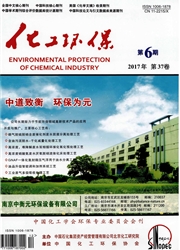

 中文摘要:
中文摘要:
以纳米TiO2为催化剂,采用超声-紫外光协同催化体系降解水中菲,并考察了菲降解率的影响因素。实验结果表明:不同类型TiO2对菲降解率的大小顺序为锐钛矿型TiO2〉P25型TiO2〉金红石型TiO2;超声-紫外光协同催化体系对菲的降解率大于单独超声体系或紫外光催化体系,且均遵从一级反应动力学规律;在超声频率为60kHz、声强为0.233W/cm2、TiO2投加量为0.06g/L、pH为4.0、H2O2浓度为19.59mmol/L的条件下降解75min后,超声-紫外光协同催化体系对初始质量浓度为0.96mg/L的菲的降解率可达76.78%。
 英文摘要:
英文摘要:
Phenanthrene in water was degraded by ultrasonic wave (US)-ultraviolet light (UV) synergetic catalytic system with TiO2 nanoparticles as catalyst. The factors affecting phenanthrene degradation were investigated. The order of degradation rate on different kinds of TiO2 was as follows: anatase TiO2 〉 P25 TiO2 〉 rutile TiO2. The phenanthrene degradation rate on US-UV synergetic catalytic system was greater than that of single US or UV photocatalytic system, their degradation processes all followed the pseudo-first order kinetics. Under the conditions of ultrasonic frequency 60 kHz, sound intensity 0.233 W/cm2, TiO2 amount 0.06 g/L, pH 4.0, H202 concentration 19.59 mmol/L, initial phenanthrene mass concentration 0.96 mg/L and reaction time 75 min. the degradation rate ofnhenanthrene reached 76.78%.
 同期刊论文项目
同期刊论文项目
 同项目期刊论文
同项目期刊论文
 期刊信息
期刊信息
